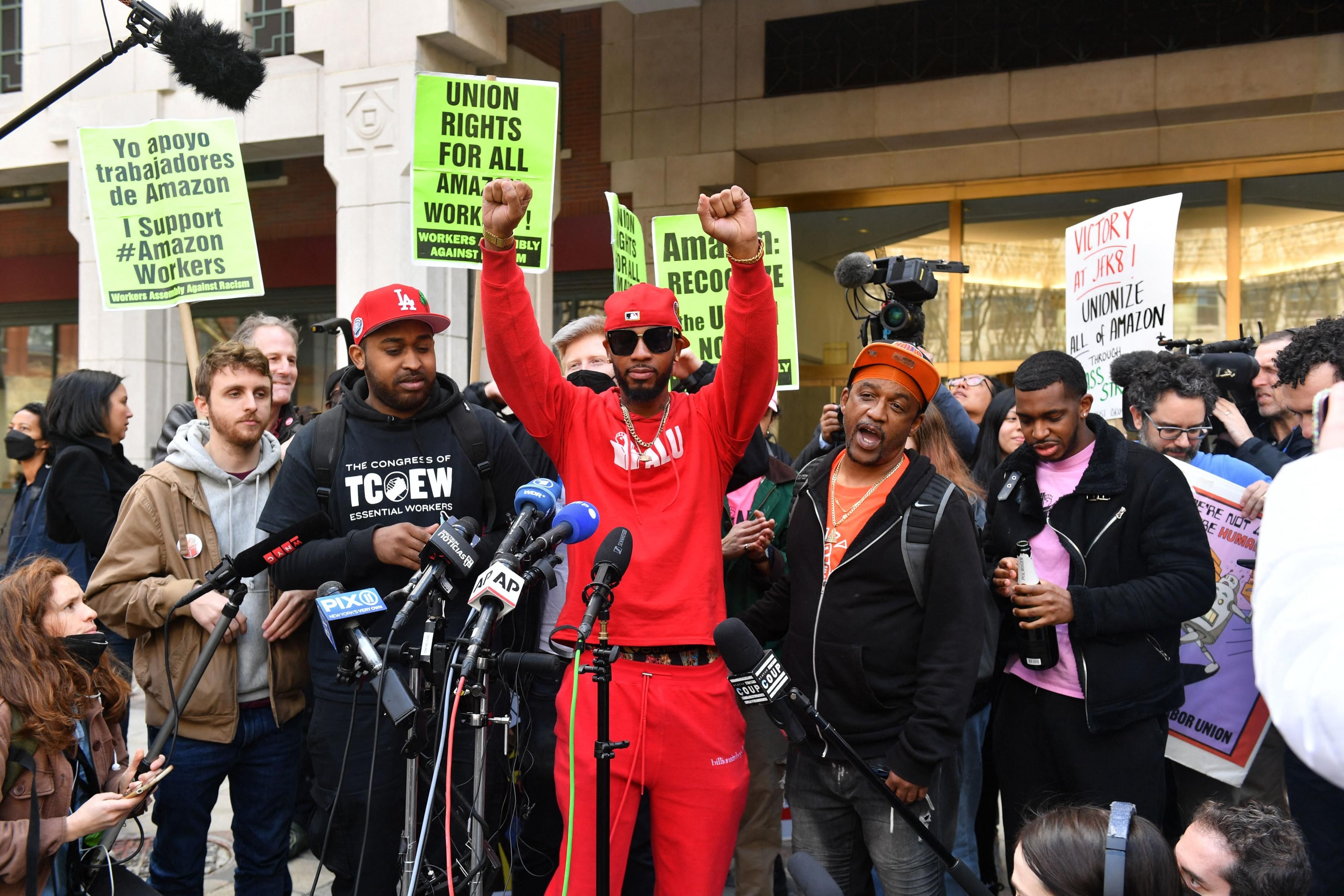Amy Goodman,
Democracy Now!
April 04, 2022

We speak with the two best friends who led a drive to organize workers at Amazon’s warehouse in Staten Island, New York, and made history Friday after a majority voted to form the first Amazon union in the U.S. We speak with Christian Smalls, interim president of the new union and former Amazon supervisor, about how he led the effort after Amazon fired him at the height of the pandemic for demanding better worker protections. “I think we proved that it’s possible, no matter what industry you work in, what corporation you work for,” says Smalls. “We just unionized Amazon. If we can do that, we can unionize anywhere.” We also speak with Derrick Palmer, who works at the Amazon JFK8 warehouse in Staten Island and is the vice president of the Amazon Labor Union, about intimidation tactics the company used. Reporter Josefa Velásquez covered the union drive for The City and discusses what the victory means for the broader labor movement.
April 04, 2022

We speak with the two best friends who led a drive to organize workers at Amazon’s warehouse in Staten Island, New York, and made history Friday after a majority voted to form the first Amazon union in the U.S. We speak with Christian Smalls, interim president of the new union and former Amazon supervisor, about how he led the effort after Amazon fired him at the height of the pandemic for demanding better worker protections. “I think we proved that it’s possible, no matter what industry you work in, what corporation you work for,” says Smalls. “We just unionized Amazon. If we can do that, we can unionize anywhere.” We also speak with Derrick Palmer, who works at the Amazon JFK8 warehouse in Staten Island and is the vice president of the Amazon Labor Union, about intimidation tactics the company used. Reporter Josefa Velásquez covered the union drive for The City and discusses what the victory means for the broader labor movement.
'Win for Workers Across America': Amazon Union Victory Inspires Progressives
"For everyone in the labor movement, it's time to dramatically rethink what we imagine is possible," said one organizer.

Amazon Labor Union organizer and president Chris Smalls celebrates following the successful unionization vote by workers at Amazon's JFK8 warehouse in Staten Island, New York on April 1, 2022. (Photo: Andrea Renault/AFP via Getty Images)
BRETT WILKINS
In what's being described as a "tremendous upset" of "David versus Goliath" proportions, employees at Amazon's JFK8 warehouse in Staten Island—led by fired worker Chris Smalls—defeated a multimillion-dollar union-busting effort by one of the world's largest and most powerful corporations and voted to form the Amazon Labor Union (ALU).
"It's official," ALU tweeted after the vote. "Amazon Labor Union is the first Amazon union in U.S. history. Power to the people!"
"This is the catalyst for the revolution," Smalls, the ALU organizer and president, said while celebrating the vote.
Erica Smiley, executive director of the labor advocacy group Jobs With Justice, said in a statement that "this triumphant union victory over Amazon represents a watershed moment in the labor movement."
"Amazon finally got what it deserved today after the trillion-dollar company ignored the demands for safer working conditions in 2020 from its workers exposed to Covid and retaliated against Christian Smalls and others who led a walkout," she said.
Smiley added that "the closeness of the election in Bessemer, Alabama"—where Amazon employees are also fighting to form a union—"is a further indication of the genuine sea-change for all Amazon workers and workers everywhere."
Varshini Prakash, executive director of the youth-led climate group Sunrise Movement, cheered Friday's "win for workers across America," while hailing "worker victories at giant corporations like Amazon and Starbucks" as "part of a growing wave of activism that is paving the way for a more just economy."
Our Revolution, the progressive political action group spun out of Sen. Bernie Sanders' (I-Vt.) 2016 presidential campaign, called the results of the vote "a massive victory" and "an inspiration for working-class people across the U.S."
Dennis Hogan, who rose to prominence organizing a graduate students' union at Brown University, tweeted: "Doubtless there will be many takes on the Amazon Labor Union's historic and little-anticipated victory in the election today. But I think a lot of it boils down to this: for everyone in the labor movement, it's time to dramatically rethink what we imagine is possible."
"There's probably never been a better time to take big risks and win," he added. "Who knows how long this window of militancy and possibility will last. Months? Years? Impossible to say. But if you're not making big moves now you risk missing it."
Eric Blanc, an assistant professor of labor studies at Rutgers University and author of Red State Revolt: The Teachers' Strike Wave and Working-Class Politics, tweeted that "the iron is hot—unions urgently need to seize the moment for new organizing."
Some labor advocates reported increased interest from workers seeing to form their own unions.
Others, including numerous Democratic U.S. lawmakers, called on Congress to pass the Protect the Right to Organize (PRO) Act, legislation whose provisions include penalties for employers who engage in union-busting activity.
"Fantastic news," Rep. Ro Khanna (D-Calif.) tweeted about the ALU vote. "Now let's get the PRO Act to [President Joe Biden's] desk to protect the right of all workers to organize."
Our work is licensed under Creative Commons (CC BY-NC-ND 3.0). Feel free to republish and share widely.
"For everyone in the labor movement, it's time to dramatically rethink what we imagine is possible," said one organizer.

Amazon Labor Union organizer and president Chris Smalls celebrates following the successful unionization vote by workers at Amazon's JFK8 warehouse in Staten Island, New York on April 1, 2022. (Photo: Andrea Renault/AFP via Getty Images)
BRETT WILKINS
April 1, 2022
Progressives hailed Friday's unionization vote by employees at an Amazon warehouse in New York City as a historic victory for workers across the United States and an inspiring call to action for others seeking to organize.
Progressives hailed Friday's unionization vote by employees at an Amazon warehouse in New York City as a historic victory for workers across the United States and an inspiring call to action for others seeking to organize.
"This is the catalyst for the revolution."
In what's being described as a "tremendous upset" of "David versus Goliath" proportions, employees at Amazon's JFK8 warehouse in Staten Island—led by fired worker Chris Smalls—defeated a multimillion-dollar union-busting effort by one of the world's largest and most powerful corporations and voted to form the Amazon Labor Union (ALU).
"It's official," ALU tweeted after the vote. "Amazon Labor Union is the first Amazon union in U.S. history. Power to the people!"
"This is the catalyst for the revolution," Smalls, the ALU organizer and president, said while celebrating the vote.
Erica Smiley, executive director of the labor advocacy group Jobs With Justice, said in a statement that "this triumphant union victory over Amazon represents a watershed moment in the labor movement."
"Amazon finally got what it deserved today after the trillion-dollar company ignored the demands for safer working conditions in 2020 from its workers exposed to Covid and retaliated against Christian Smalls and others who led a walkout," she said.
Smiley added that "the closeness of the election in Bessemer, Alabama"—where Amazon employees are also fighting to form a union—"is a further indication of the genuine sea-change for all Amazon workers and workers everywhere."
Varshini Prakash, executive director of the youth-led climate group Sunrise Movement, cheered Friday's "win for workers across America," while hailing "worker victories at giant corporations like Amazon and Starbucks" as "part of a growing wave of activism that is paving the way for a more just economy."
Our Revolution, the progressive political action group spun out of Sen. Bernie Sanders' (I-Vt.) 2016 presidential campaign, called the results of the vote "a massive victory" and "an inspiration for working-class people across the U.S."
Dennis Hogan, who rose to prominence organizing a graduate students' union at Brown University, tweeted: "Doubtless there will be many takes on the Amazon Labor Union's historic and little-anticipated victory in the election today. But I think a lot of it boils down to this: for everyone in the labor movement, it's time to dramatically rethink what we imagine is possible."
"There's probably never been a better time to take big risks and win," he added. "Who knows how long this window of militancy and possibility will last. Months? Years? Impossible to say. But if you're not making big moves now you risk missing it."
Eric Blanc, an assistant professor of labor studies at Rutgers University and author of Red State Revolt: The Teachers' Strike Wave and Working-Class Politics, tweeted that "the iron is hot—unions urgently need to seize the moment for new organizing."
Some labor advocates reported increased interest from workers seeing to form their own unions.
Others, including numerous Democratic U.S. lawmakers, called on Congress to pass the Protect the Right to Organize (PRO) Act, legislation whose provisions include penalties for employers who engage in union-busting activity.
"Fantastic news," Rep. Ro Khanna (D-Calif.) tweeted about the ALU vote. "Now let's get the PRO Act to [President Joe Biden's] desk to protect the right of all workers to organize."
Our work is licensed under Creative Commons (CC BY-NC-ND 3.0). Feel free to republish and share widely.

















